Python is a high-level, interpreted programming language known for its readability and simplicity. Created by Guido van Rossum and first released in 1991, Python has gained widespread popularity in various domains, including web development, data analysis, artificial intelligence, scientific computing, and more.
Key features of Python include:
1. **Readability:** Python's syntax is designed to be clear and concise, making it easy to write and understand code.
2. **Versatility:** Python supports multiple programming paradigms, including procedural, object-oriented, and functional programming.
3. **Extensive Libraries:** Python has a rich ecosystem of libraries and frameworks that facilitate various tasks, from web development (Django, Flask) to data analysis (NumPy, pandas) and machine learning (TensorFlow, PyTorch).
4. **Community Support:** Python has a large and active community, contributing to its open-source development and providing ample resources for learning and problem-solving.
5. **Platform Independence:** Python is platform-independent, meaning that code written in Python can run on different operating systems with little to no modification.
Python's versatility and ease of use make it a popular choice for both beginners and experienced developers.
Why its becoming most popular?
Python has become increasingly popular for several reasons:
1. **Readability and Simplicity:** Python's syntax is designed to be readable and easy to understand. This makes it accessible for beginners and contributes to faster development.
2. **Versatility:** Python supports multiple programming paradigms, allowing developers to choose the approach that best suits their needs. This versatility makes it applicable to various domains, from web development to data science and artificial intelligence.
3. **Rich Ecosystem:** Python has a vast ecosystem of libraries and frameworks for different purposes. This reduces the need to build everything from scratch and accelerates development.
4. **Community Support:** Python has a large and active community of developers. This community support is valuable for learning, problem-solving, and staying updated on the latest developments in the language.
5. **Open Source:** Python is open-source, meaning that its source code is freely available for anyone to view, use, and modify. This openness encourages collaboration and innovation.
6. **Data Science and Machine Learning:** Python has become a dominant language in data science and machine learning. Libraries like NumPy, pandas, TensorFlow, and PyTorch contribute to its widespread adoption in these fields.
7. **Web Development Frameworks:** Frameworks like Django and Flask have made Python a popular choice for web development. They provide efficient tools for building scalable and maintainable web applications.
8. **Educational Use:** Python is often recommended for beginners due to its readability and simplicity. Its use in educational institutions has contributed to a growing pool of developers with Python skills.
The combination of these factors has propelled Python's popularity, making it one of the most widely used programming languages across different industries and applications.

